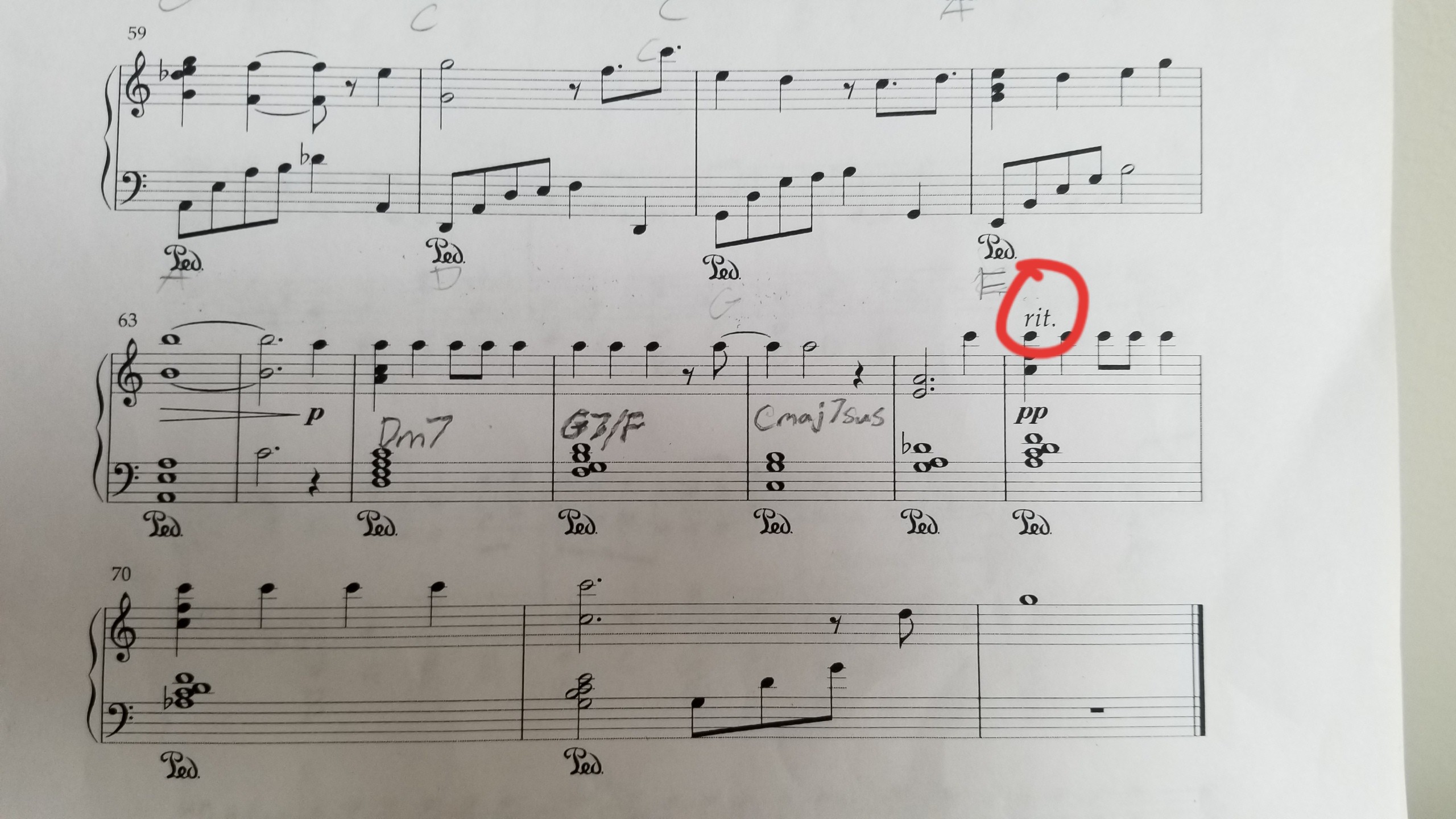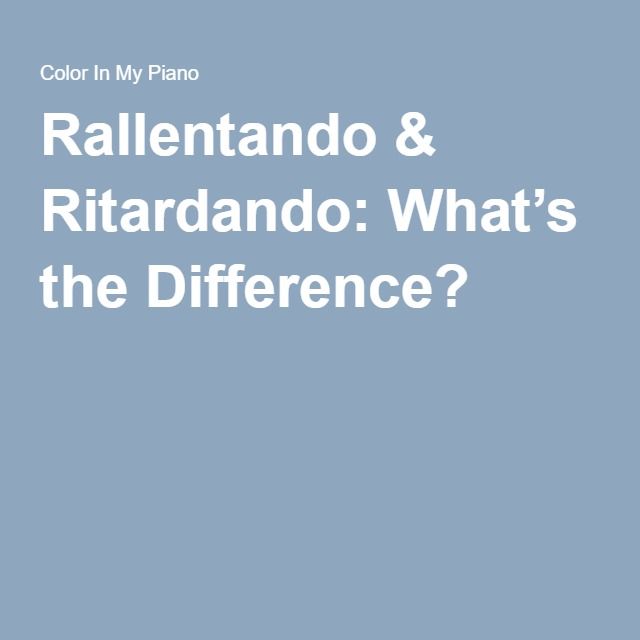In the world of music, two terms often used interchangeably are rallentando and ritardando. While both markings indicate a gradual slowdown in tempo, there is a subtle difference between the two. Rallentando is an Italian word meaning “slowing down,” typically used to prepare the listener for a change in tempo or key. On the other hand, ritardando means “slowing down and then stopping,” implying either a gradual or sudden slowdown followed by a complete stop. Rallentando is more associated with creating a sense of relaxation or mellowness, while ritardando is used to build tension. Understanding the distinction between these terms is crucial for musicians, as they add nuance and shading to their performances.

What is Rallentando?
Definition of Rallentando
Rallentando, abbreviated as “rall.”, is an Italian musical term that translates to “slowing down” in English. It is used to indicate a gradual decrease in tempo or speed of a musical piece. Rallentando is typically placed at the end of a phrase or section of music to prepare the listener for a change in tempo or key.
Usage of Rallentando
Rallentando is commonly used in classical and romantic music genres, where it is often used to create a sense of relaxation or mellowness. It is an instruction to the performer to gradually slow down the tempo of the music. By doing so, the performer can add expression and emotion to their performance, enhancing the musical experience for the listener. Rallentando can be used to mark the end of a musical phrase, an important section, or to transition between different sections of a composition.
Meaning of Rallentando
Rallentando is not only a tempo marking, but it also carries meaning and intention in the music. It signals to the performer to bring the music to a slower pace, allowing for more expressive playing and emphasizing certain musical elements. Rallentando can convey a sense of relaxation, giving the music a smoother and more gentle quality. It adds nuance and shading to the performance, enhancing the overall musical experience.
What is Ritardando?
Definition of Ritardando
Ritardando, abbreviated as “rit.”, is another Italian musical term that means “slowing down and then stopping” in English. It is used to indicate a gradual or sudden decrease in tempo, followed by a complete stop. Ritardando is a more abrupt and deliberate way of slowing down the music compared to rallentando.
Usage of Ritardando
Similar to rallentando, ritardando is also commonly used in classical and romantic music genres. It can be used to create tension, suspense, or a sense of anticipation in the music. Ritardando is often employed at the end of a piece or a section to bring it to a graceful and dramatic conclusion. It can also be used within a piece to highlight a significant musical moment or to transition between different sections.
Meaning of Ritardando
Ritardando, like rallentando, serves as an instruction to the performer to alter the tempo of the music. However, ritardando can be more sudden and deliberate, bringing the music to a stop, rather than a gradual slowdown. It adds a sense of drama and intensity to the performance, creating tension and capturing the listener’s attention. Ritardando can also be used as a natural tempo change, occurring organically within the music.
Difference Between Rallentando & Ritardando
Definition of Rallentando
Rallentando is a gradual decrease in tempo or speed of the music. It is an Italian musical term that translates to “slowing down.” Rallentando is typically used at the end of a phrase or section to prepare the listener for a change in tempo or key.
Definition of Ritardando
Ritardando, on the other hand, is a decrease in tempo that can be gradual or sudden, followed by a complete stop. It is an Italian musical term that means “slowing down and then stopping.”
Speed and Tempo
The main difference between rallentando and ritardando lies in the speed and tempo of the music. Rallentando signifies a gradual slowdown, while ritardando can indicate either a gradual or sudden decrease in tempo.
Sense and Purpose
While both rallentando and ritardando are used for effect in music, they serve slightly different purposes. Rallentando is typically used to create a sense of relaxation or mellowness in the music, while ritardando is used to create tension, suspense, or anticipation.
Nuance and Shading
Rallentando and ritardando also differ in terms of nuance and shading. Rallentando adds a smoother and more gentle quality to the music, while ritardando adds drama and intensity.
Instruction and Natural Tempo Change
Another distinction between rallentando and ritardando is their usage as instructions to the performer. Rallentando is specifically an instruction, telling the performer to slow down gradually. On the other hand, ritardando can be an instruction to the performer or a natural tempo change that occurs within the music.
Importance of Understanding the Difference
Effect on Performance
Understanding the difference between rallentando and ritardando is crucial for musicians as it has a direct impact on their performance. Knowing when to use each term appropriately allows performers to accurately convey the intended mood and emotions of the music.
Artistic Interpretation
Differentiating between rallentando and ritardando enables musicians to make informed artistic interpretations. By understanding the nuances of these terms, performers can add depth and expression to their playing, making the music more engaging and compelling.
Communication with Other Musicians
Having a clear understanding of rallentando and ritardando facilitates effective communication among musicians. When musicians are familiar with these terms and their distinctions, they can confidently discuss and collaborate on their musical interpretations and performances.
Enhancing Musical Expressiveness
By grasping the difference between rallentando and ritardando, musicians can enhance their musical expressiveness. They can use these tempo markings strategically to evoke specific emotions, create tension and release, and captivate the listener through their performance.

Applications in Music
Compositional Techniques
Rallentando and ritardando are frequently employed by composers as compositional techniques. Composers use these tempo markings to shape the structure and emotional arc of their compositions, manipulating the speed of the music to convey their intended message.
Performance Techniques
For performers, rallentando and ritardando offer opportunities to showcase their technical skills and interpretive abilities. Musicians can use these tempo markings to create emphasis, highlight musical moments, and craft their performances with precision and artistry.
Interpretation by Musicians
Understanding the difference between rallentando and ritardando is essential for musicians when interpreting a piece of music. By correctly applying these tempo markings, musicians can bring out the intended emotions, dynamics, and overall musicality of a composition.
Historical Significance
Both rallentando and ritardando have been used throughout the history of music. Studying and understanding the usage of these tempo markings in different musical eras can provide insights into the stylistic conventions and intentions of composers from various periods.
Common Misconceptions
Misuse of Terminology
One common misconception is the interchangeable usage of rallentando and ritardando. While they are similar in meaning, there is a distinction between them in terms of speed and intent. It is important to use the correct terminology to accurately convey the desired effect in the music.
Confusion in Notation
Another misconception arises from the confusion in notation. Rallentando is often notated with the abbreviation “rall.”, while ritardando is abbreviated as “rit.” or “ritard.”. Musicians should pay attention to the notation and markings in the sheet music to accurately interpret and perform the intended tempo changes.
Interchangeable Usage
Although rallentando and ritardando have distinct meanings, there are instances where they can be used interchangeably. It ultimately depends on the composer’s intention and the desired effect in the music. However, it is still essential for musicians to understand the differences between these terms and use them accordingly.

Educational Resources
Books
Several books can provide in-depth explanations and examples of rallentando and ritardando in music. Some recommended titles include “The Study of Orchestration” by Samuel Adler and “The Complete Idiot’s Guide to Music Composition” by Michael Miller.
Online Courses
Online platforms like Coursera and Udemy offer courses on music theory and performance that cover topics related to rallentando and ritardando. These courses provide structured lessons, practice exercises, and interactive discussions to enhance understanding and proficiency in these musical terms.
Musical Terminology Guides
There are numerous guides and dictionaries specifically dedicated to musical terminology, including rallentando and ritardando. These references, such as “The Oxford Dictionary of Musical Terms” by Alison Latham, provide comprehensive definitions and explanations for a wide range of musical terms.
Tutorials and Demonstrations
Online tutorials and video demonstrations can be valuable resources for visual and aural learners. Platforms like YouTube offer a wealth of instructional videos by professional musicians and music educators, where they explain and demonstrate the nuances and applications of rallentando and ritardando in different musical contexts.
Conclusion
Rallentando and ritardando are tempo markings that indicate a decrease in tempo or speed of a musical piece. While they are often used interchangeably, there are notable differences between them. Rallentando implies a gradual slowdown, often used to create relaxation or mellowness. On the other hand, ritardando can be gradual or sudden, leading to a complete stop, and is used to generate tension or anticipation. Understanding the distinctions between these terms is essential for musicians as it affects their performance, artistic interpretation, and communication with other musicians. Rallentando and ritardando have applications in composition, performance, interpretation, and have historical significance. Avoiding common misconceptions and utilizing educational resources can further enhance musicians’ comprehension and proficiency in these musical terms. By mastering rallentando and ritardando, musicians can elevate their musical expressiveness and captivate listeners with their performances.







